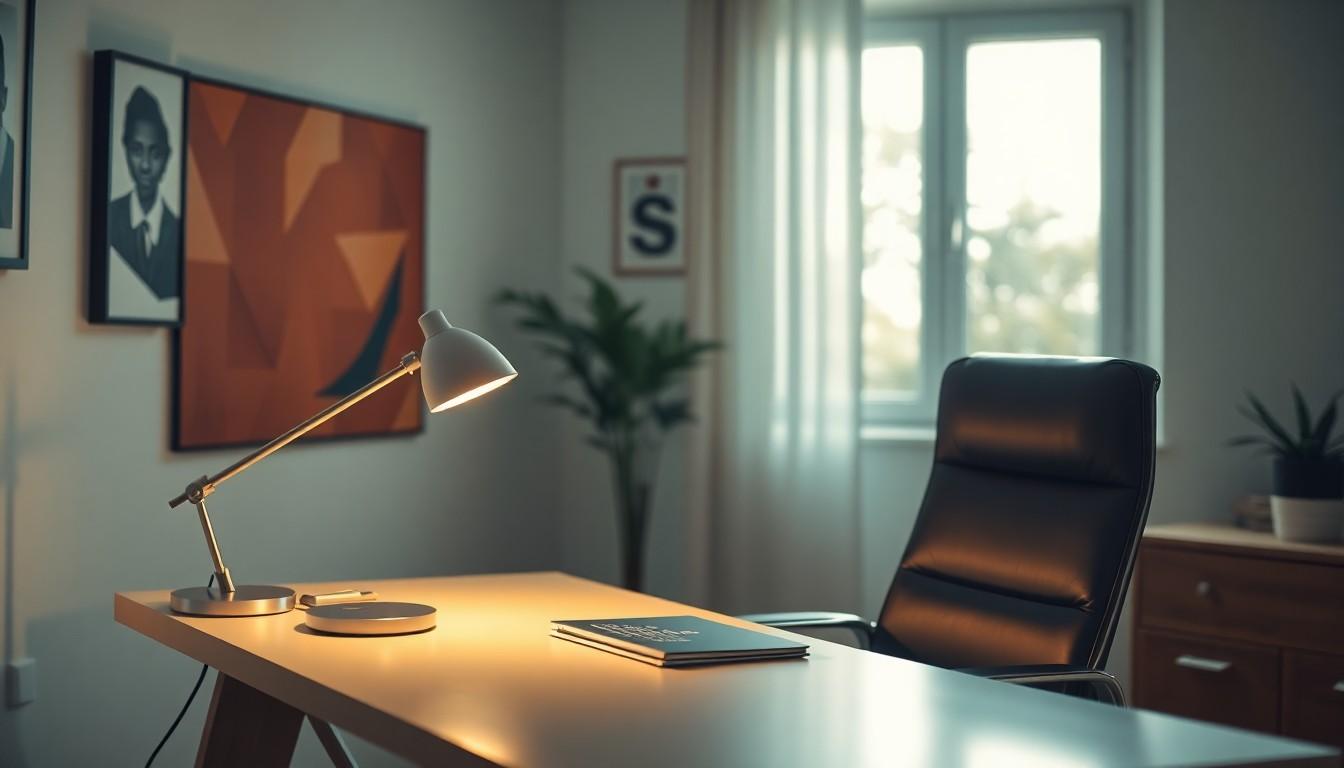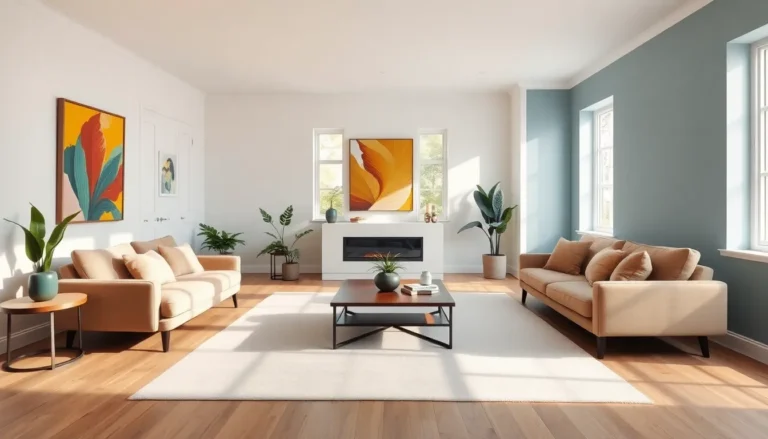In the world of remote work, a well-lit home office isn’t just a luxury—it’s a necessity. Imagine squinting at your screen like a confused raccoon in the dark. Not the best way to impress your boss during a video call, right? The right lighting can transform a mundane workspace into a productivity powerhouse, making those long hours feel less like a scene from a horror movie.
Table of Contents
ToggleImportance of Lighting for Home Office
Proper lighting plays a critical role in a home office setup. It drives productivity and promotes a comfortable workspace.
Enhancing Productivity
Bright, well-distributed light boosts productivity in a home office. Natural light exposure increases energy levels and enhances focus. Studies show that workers near windows report higher satisfaction and efficiency. Incorporating task lighting helps illuminate specific areas, reducing shadows that can disrupt work. Choosing adjustable fixtures allows individuals to tailor brightness to different tasks. With the right lighting conditions, employees complete tasks quicker and with greater accuracy.
Reducing Eye Strain
Proper lighting minimizes eye strain during long hours of work. An overly dim or bright environment causes fatigue and discomfort. It’s essential to have light that doesn’t glare on screens, as this can lead to headaches. Implementing a combination of ambient and task lighting creates balance and reduces harsh contrasts. Utilizing blue light filters can further protect the eyes during screen time. Regular breaks from light exposure also support eye health and maintain focus.
Types of Lighting

Different types of lighting contribute to an effective home office setup. Each plays a role in enhancing productivity and comfort during work hours.
Ambient Lighting
Ambient lighting serves as the primary source of illumination in the office. It provides an overall glow that ensures even light distribution throughout the space. Using overhead fixtures or wall-mounted lights achieves this effect. Natural light also plays a vital role, so placing the workspace near windows enhances the room’s lighting quality. A well-lit area not only boosts mood but also encourages focus and energy. Choosing warm-toned bulbs can create a more welcoming atmosphere.
Task Lighting
Task lighting focuses on specific work areas, ensuring tasks are clearly visible. Desk lamps or under-shelf lights provide adequate brightness where needed. Adjustability allows users to direct light exactly where it’s most effective. Incorporating resources such as LED task lights can reduce eye strain during prolonged use. Combining task lighting with ambient light minimizes shadows and enhances visibility. These features ultimately lead to improved productivity by supporting detailed work.
Accent Lighting
Accent lighting adds visual interest and creates a distinct atmosphere in the office. Use floor lamps, wall sconces or decorative fixtures to highlight artwork or architectural features. Highlighting these elements can inspire creativity and contribute to a stimulating work environment. Task lighting and ambient lighting complement accent lights, creating balance. Synchronizing various lighting types encourages productivity while maintaining aesthetic appeal. Utilizing dimmers allows for flexibility in mood and brightness levels.
Best Fixtures for Home Office
Choosing the right fixtures enhances the work environment and boosts productivity in a home office. Various options serve specific functions, ensuring adequate illumination throughout the space.
Desk Lamps
Desk lamps excel at providing focused light directly where it’s needed. Adjustable models allow for tilting and height changes, aiding in directing light precisely toward work materials. For energy efficiency, LED desk lamps often come with features like color temperature settings, enabling users to customize the light for different tasks. Selecting lamps with built-in USB ports adds convenience by allowing charging devices without extra outlets. Brands like BenQ and TaoTronics offer quality options suitable for diverse preferences.
Overhead Lights
Overhead lights serve as the primary illumination source in a home office, creating a broad pool of light. Recessed lighting fixtures offer a sleek appearance, while pendant lights introduce a focal design element. Installing dimmers gives flexibility for adjusting brightness based on the time of day and task requirements. Opting for fixtures with a high Color Rendering Index (CRI) enhances visual clarity, making colors appear more vibrant. Modern fluorescent or LED options provide energy efficiency while delivering high illumination levels.
Floor Lamps
Floor lamps add versatility and additional lighting without requiring desk space. Adjustable models offer directional lighting that can enhance areas used for reading or brainstorming. Styles range from minimalist designs to more ornate options, complementing various decor themes. Using a combination of warm and cool bulbs creates an inviting ambiance while enhancing focus. Brands such as Brightech and Philips provide diverse choices that cater to different lighting needs and aesthetic preferences.
Tips for Effective Lighting
Effective lighting enhances productivity and comfort in a home office. Specific strategies optimize the workspace experience.
Color Temperature
Choose a color temperature that promotes alertness and focus. Bright white light, around 5000K to 6500K, creates an energized atmosphere. Warmer tones, between 2700K and 3000K, offer a cozy environment suitable for relaxation. Balance lighting by mixing different color temperatures to adapt to various tasks. Consider LED bulbs for their energy efficiency and available color options.
Positioning Lights
Position lights to minimize glare and shadows on work surfaces. Desk lamps should sit at a 30-degree angle to tasks, providing direct illumination. Overhead lights must illuminate the entire room evenly, reducing dark corners. Place floor lamps in the corners to create gradual light effects and enhance visibility. Assess your layout regularly to ensure optimal light placement for changing activity needs.
Adjusting Brightness
Adjust brightness levels based on time of day and task demands. Dimmers allow for customization, creating a focus-friendly environment. During daytime, utilize natural light by positioning the desk near windows but avoid harsh glare. In the evening, reduce light intensity to ease eyestrain and promote relaxation. Regularly adjust lighting to suit different work activities, enhancing both comfort and productivity.
Creating an effective home office lighting setup is essential for enhancing productivity and comfort. By combining ambient and task lighting with thoughtful fixture choices, individuals can transform their workspace into a more inviting and efficient environment.
Incorporating adjustable lighting options like dimmers allows for flexibility throughout the day, catering to different tasks and moods. Prioritizing eye health with proper positioning and color temperature not only reduces strain but also keeps energy levels high.
Ultimately, investing time and resources into the right lighting can lead to a more satisfying and productive remote work experience.




